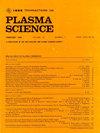Thermal Effects of Low-Pressure Glow Discharge and Its Heat Transfer Through the Discharge Tube
IF 1.3
4区 物理与天体物理
Q3 PHYSICS, FLUIDS & PLASMAS
引用次数: 0
Abstract
The light emitted by gas discharge plasma is often used as a light source for precision optical instruments. The measurement precision and accuracy of these precision instruments are greatly affected by the ambient temperature. In fact, although low-pressure glow gas discharge plasma is often referred to as “low-temperature plasma,” it may also have thermal effects under prolonged operation. There is a lack of research on the thermal effects of low-pressure glow discharges and the process of its heat transfer through the discharge tube. In this article, a 2-D axisymmetric fluid model is established, coupling multiphysics fields such as discharge plasma, laminar flow, and heat transfer. The thermal effect and heat transfer of He/Ne gas mixture glow discharge at low pressure are investigated. Studies show that, after the discharge has lasted for a certain period of time, the temperature in the gas discharge region is significantly elevated and can reach tens or hundreds of kelvins. The temperature of the glass tube may also increase by more than 20 K under certain discharge parameters. The current-limiting resistance, the gas pressure, and the He/Ne gas ratio have a large influence on the thermal effect of the gas discharge. Therefore, the thermal effect of gas discharge applied as a light source in precision optical instruments cannot be ignored and needs to be regulated and designed for specific situations. This article contributes to a deeper physical understanding of the thermal effects of low-pressure glow discharges and provides guidance for their optical application.气体放电等离子体发出的光经常被用作精密光学仪器的光源。这些精密仪器的测量精度和准确度在很大程度上受到环境温度的影响。事实上,虽然低压辉光气体放电等离子体通常被称为 "低温等离子体",但它在长时间工作的情况下也会产生热效应。有关低压辉光放电的热效应及其通过放电管传热过程的研究还很缺乏。本文建立了一个二维轴对称流体模型,耦合了放电等离子体、层流和传热等多物理场。研究了低压下氦/氖混合气体辉光放电的热效应和热传递。研究表明,放电持续一段时间后,气体放电区的温度会明显升高,可达几十或几百开尔文。在某些放电参数下,玻璃管的温度也可能升高 20 K 以上。限流电阻、气体压力和氦/氖气体比对气体放电的热效应有很大影响。因此,在精密光学仪器中用作光源的气体放电的热效应不容忽视,需要根据具体情况进行调节和设计。本文有助于加深对低压辉光放电热效应的物理理解,并为其光学应用提供指导。
本文章由计算机程序翻译,如有差异,请以英文原文为准。
求助全文
约1分钟内获得全文
求助全文
来源期刊

IEEE Transactions on Plasma Science
物理-物理:流体与等离子体
CiteScore
3.00
自引率
20.00%
发文量
538
审稿时长
3.8 months
期刊介绍:
The scope covers all aspects of the theory and application of plasma science. It includes the following areas: magnetohydrodynamics; thermionics and plasma diodes; basic plasma phenomena; gaseous electronics; microwave/plasma interaction; electron, ion, and plasma sources; space plasmas; intense electron and ion beams; laser-plasma interactions; plasma diagnostics; plasma chemistry and processing; solid-state plasmas; plasma heating; plasma for controlled fusion research; high energy density plasmas; industrial/commercial applications of plasma physics; plasma waves and instabilities; and high power microwave and submillimeter wave generation.
 求助内容:
求助内容: 应助结果提醒方式:
应助结果提醒方式:


